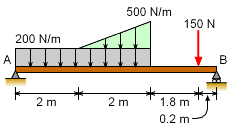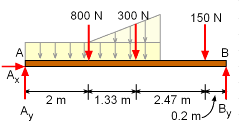| Ch 5. Rigid Body Equilibrium | Multimedia Engineering Statics | ||||||
|
2-D and 3-D Supports |
Equilibrium in 2-D |
Equilibrium in 3-D |
Indeterminate Objects | 2 and 3 Force Members | |||
| Equilibrium in 2-D | Case Intro | Theory | Case Solution | Example |
| Chapter |
| 1. Basics |
| 2. Vectors |
| 3. Forces |
| 4. Moments |
| 5. Rigid Bodies |
| 6. Structures |
| 7. Centroids/Inertia |
| 8. Internal Loads |
| 9. Friction |
| 10. Work & Energy |
| Appendix |
| Basic Math |
| Units |
| Sections |
| eBooks |
| Dynamics |
| Fluids |
| Math |
| Mechanics |
| Statics |
| Thermodynamics |
| ©Kurt Gramoll |
| STATICS - EXAMPLE |
||
| Example |
||
|
|
Calculate the reaction forces acting at A and B on the beam. |
|
| Solution |
||
|
|
First convert the distributed loads into point loads and find their locations. For a rectangular uniform distributed load, the magnitude of the resultant force will be the product of the length of the rectangle and value of the distributed load. The location of the force resultant is always the center point (centroid) of the distributed load. The magnitude of the resultant force will be (200 N/m) (4 m) = 800 N and it will be at 2 m away from support A. For a triangular line load, the force resultant is one half of the peak value of the distributed load multiplied by the distance over which it acts. The location of the force resultant is two-thirds of the distance from the vertex to the peak value of the load. The magnitude of the resultant force will be (1/2) (2) (500 - 200) = 300 N and it is at 1.33 m from left vertex. The actual reactions can be found by applying equilibrium equations |
|
There will be three possible reactions at A and B namely Ax, Ay and By. which can be found by applying the equilibrium equations. ΣMA = 0 Equating forces give, ΣFy = 0 Since there is no horizontal applied load, Ax will be zero. | ||

